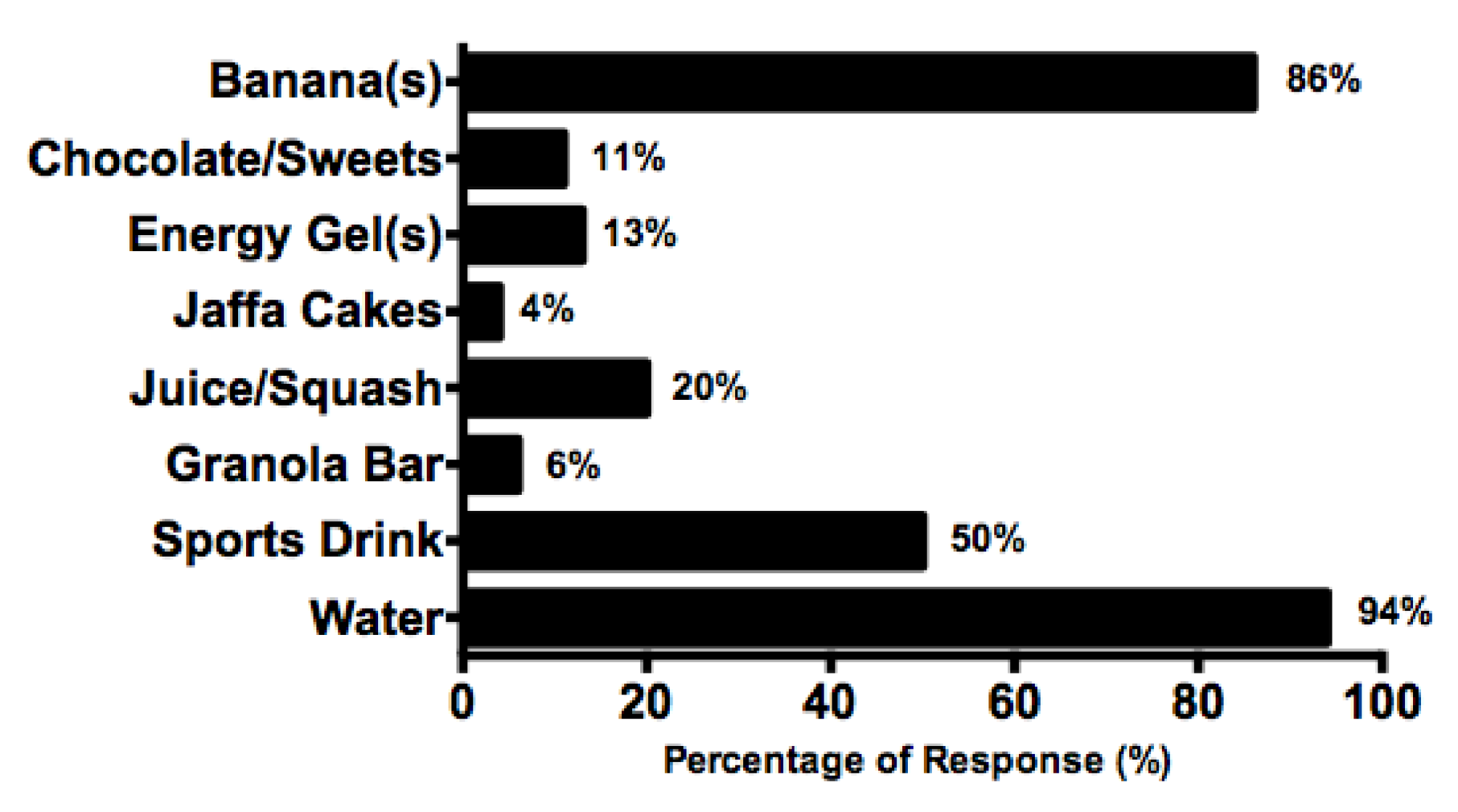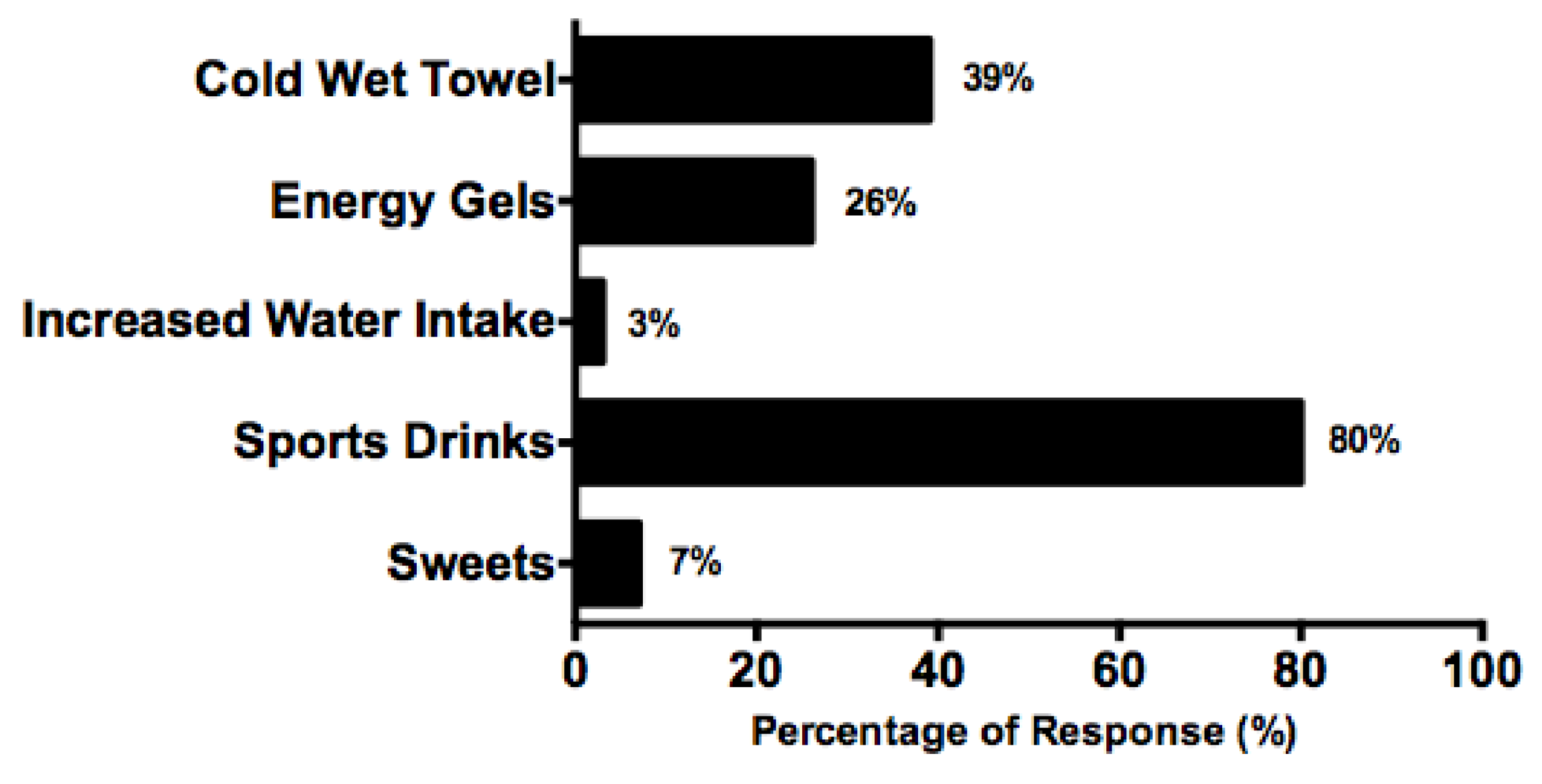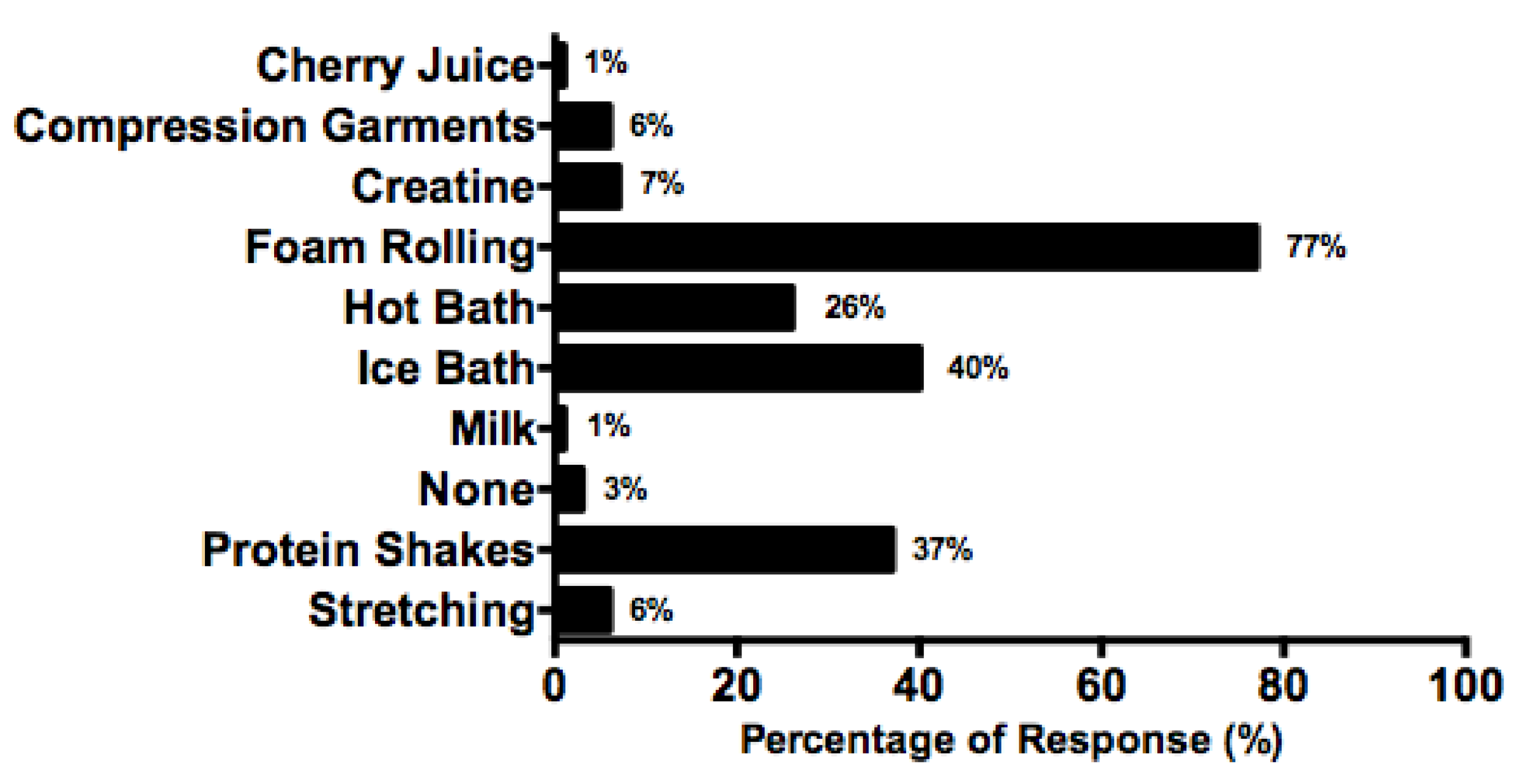Investigating the Nutritional and Recovery Habits of Tennis Players
Abstract
1. Introduction
2. Materials and Methods
2.1. Participants and Study Design
2.2. Questionnaire Topics
2.2.1. Match Preparation
2.2.2. Intra-Match Nutritional Habits
2.2.3. Situation Dependent Variables
2.2.4. Post-Match Nutrition and Recovery
2.3. Data Analysis
3. Results
3.1. Match Preparation
3.2. Intra-Match Nutritional Habits
3.3. Situation Dependent Variables
3.4. Post-Match Nutrition and Recovery
3.5. Sub-Analysis by Playing Standard–‘Elite’ vs. Lower Level Players
3.6. Sub-Analysis by Age–Juniors vs. Adult Players
3.7. Sub-Analysis by Gender
4. Discussion
5. Conclusions
Supplementary Materials
Acknowledgments
Author Contributions
Conflicts of Interest
References
- Kondric, M.; Sekulic, D.; Uljevic, O.; Gabrilo, G.; Zvan, M. Sport nutrition and doping in tennis: An analysis of athletes’ attitudes and knowledge. J. Sports Sci. Med. 2013, 12, 290–297. [Google Scholar] [PubMed]
- Ranchordas, M.K.; Rogersion, D.; Ruddock, A.; Killer, S.C.; Winter, E.M. Nutrition for Tennis: Practical Recommendations. J. Sports Sci. Med. 2013, 12, 211–224. [Google Scholar] [PubMed]
- Ojala, T.; Häkkinen, K. Effects of the tennis tournament on players’ physical performance, hormonal responses, muscle damage and recovery. J. Sports Sci. Med. 2013, 12, 240–248. [Google Scholar] [PubMed]
- Kovacs, M.S. Carbohydrate intake and tennis: Are there benefits? Br. J. Sports Med. 2006, 40, e13. [Google Scholar] [CrossRef] [PubMed]
- Fernandez, J.; Mendez-Villanueva, A.; Pluim, B.M. Intensity of tennis match play. Br. J. Sports Med. 2006, 40, 387–391. [Google Scholar] [CrossRef] [PubMed]
- Girard, O.; Racinais, S.; Micallef, J.-P.; Millet, G.P. Spinal modulations accompany peripheral fatigue during prolonged tennis playing. Scand. J. Med. Sci. Sports 2011, 21, 455–464. [Google Scholar] [CrossRef] [PubMed]
- Kovacs, M.S. Tennis physiology: Training the competitive athlete. Sports Med. Auckl. N. Z. 2007, 37, 189–198. [Google Scholar] [CrossRef]
- Gomes, R.V.; Santos, R.C.O.; Nosaka, K.; Moreira, A.; Miyabara, E.H.; Aoki, M.S. Muscle damage after a tennis match in young players. Biol. Sport 2014, 31, 27–32. [Google Scholar] [CrossRef] [PubMed]
- Kovacs, M.S.; Baker, L.B. Recovery interventions and strategies for improved tennis performance. Br. J. Sports Med. 2014, 48, i18–i21. [Google Scholar] [CrossRef] [PubMed]
- Kerksick, C.; Harvey, T.; Stout, J.; Campbell, B.; Wilborn, C.; Kreider, R.; Kalman, D.; Ziegenfuss, T.; Lopez, H.; Landis, J.; et al. International Society of Sports Nutrition position stand: Nutrient timing. J. Int. Soc. Sports Nutr. 2008, 5, 17. [Google Scholar] [CrossRef] [PubMed]
- Thomas, D.T.; Erdman, K.A.; Burke, L.M. American College of Sports Medicine Joint Position Statement. Nutrition and Athletic Performance. Med. Sci. Sports Exerc. 2016, 48, 543–568. [Google Scholar] [PubMed]
- Moran, D.S.; Heled, Y.; Arbel, Y.; Israeli, E.; Finestone, A.S.; Evans, R.K.; Yanovich, R. Dietary intake and stress fractures among elite male combat recruits. J. Int. Soc. Sports Nutr. 2012, 9, 6. [Google Scholar] [CrossRef] [PubMed]
- Nimmo, M.A.; Ekblom, B. International Association of Athletics Federations Fatigue and illness in athletes. J. Sports Sci. 2007, 25 (Suppl. 1), S93–S102. [Google Scholar] [CrossRef] [PubMed]
- Ziegler, P.J.; Jonnalagadda, S.S.; Nelson, J.A.; Lawrence, C.; Baciak, B. Contribution of meals and snacks to nutrient intake of male and female elite figure skaters during peak competitive season. J. Am. Coll. Nutr. 2002, 21, 114–119. [Google Scholar] [CrossRef] [PubMed]
- Devlin, B.L.; Belski, R. Exploring General and Sports Nutrition and Food Knowledge in Elite Male Australian Athletes. Int. J. Sport Nutr. Exerc. Metab. 2015, 25, 225–232. [Google Scholar] [CrossRef] [PubMed]
- Chlíbková, D.; Knechtle, B.; Rosemann, T.; Tomášková, I.; Chadim, V.; Shortall, M. Nutrition habits in 24-hour mountain bike racers. Springer Plus 2014, 3, 715. [Google Scholar] [CrossRef] [PubMed]
- Juzwiak, C.R.; Amancio, O.M.S.; Vitalle, M.S.S.; Pinheiro, M.M.; Szejnfeld, V.L. Body composition and nutritional profile of male adolescent tennis players. J. Sports Sci. 2008, 26, 1209–1217. [Google Scholar] [CrossRef] [PubMed]
- Steen, S.N. Timely statement of the American Dietetic Association: Nutrition guidance for adolescent athletes in organized sports. J. Am. Diet. Assoc. 1996, 96, 611–612. [Google Scholar] [CrossRef]
- Dascombe, B.J.; Karunaratna, M.; Cartoon, J.; Fergie, B.; Goodman, C. Nutritional supplementation habits and perceptions of elite athletes within a state-based sporting institute. J. Sci. Med. Sport 2010, 13, 274–280. [Google Scholar] [CrossRef] [PubMed]
- Ward, P.; Clark, T.; Zabriskie, R.; Morris, T. Paper/Pencil versus Online Data Collection. J. Leis. Res. 2014, 46, 84–105. [Google Scholar] [CrossRef]
- Harper, L.D.; McCunn, R. “Hand in Glove”: Using Qualitative Methods to Connect Research and Practice. Int. J. Sports Physiol. Perform. 2017, 12, 990–993. [Google Scholar] [CrossRef] [PubMed]
- Thomas, D.R. A General Inductive Approach for Analyzing Qualitative Evaluation Data. Am. J. Eval. 2006, 27, 237–246. [Google Scholar] [CrossRef]
- Moreno-Pérez, V.; Lopez-Valenciano, A.; Barbado, D.; Moreside, J.; Elvira, J.L.L.; Vera-Garcia, F.J. Comparisons of hip strength and countermovement jump height in elite tennis players with and without acute history of groin injuries. Musculoskelet. Sci. Pract. 2017, 29, 144–149. [Google Scholar] [CrossRef] [PubMed]
- Kramer, T.; Huijgen, B.C.H.; Elferink-Gemser, M.T.; Visscher, C. Prediction of Tennis Performance in Junior Elite Tennis Players. J. Sports Sci. Med. 2017, 16, 14–21. [Google Scholar] [PubMed]
- Tennis, A.U. The Universal Tennis 16-Level Chart. University Tennis 2017. Available online: https://blog.universaltennis.com/2017/06/29/the-universal-tennis-16-level-chart/ (accessed on 4 September 2017).
- Burke, L.M.; Hawley, J.A.; Wong, S.H.S.; Jeukendrup, A.E. Carbohydrates for training and competition. J. Sports Sci. 2011, 29 (Suppl. 1), S17–S27. [Google Scholar] [CrossRef] [PubMed]
- Jeukendrup, A. A Step towards Personalized Sports Nutrition: Carbohydrate Intake during Exercise. Sports Med. Auckl. N. Z. 2014, 44, 25–33. [Google Scholar] [CrossRef] [PubMed]
- Cheyette, C.; Balolia, Y. Carbs & Cals: Count Your Carbs & Calories with over 1700 Food & Drink Photos, 6th ed.; Chello: London, UK, 2016; ISBN 978-1-908261-15-1. [Google Scholar]
- Spriet, L.L. New Insights into the Interaction of Carbohydrate and Fat Metabolism during Exercise. Sports Med. Auckl. N. Z. 2014, 44, 87–96. [Google Scholar] [CrossRef] [PubMed]
- Pfeiffer, B.; Stellingwerff, T.; Zaltas, E.; Jeukendrup, A.E. Oxidation of solid versus liquid CHO sources during exercise. Med. Sci. Sports Exerc. 2010, 42, 2030–2037. [Google Scholar] [CrossRef] [PubMed]
- Foskett, A.; Williams, C.; Boobis, L.; Tsintzas, K. Carbohydrate availability and muscle energy metabolism during intermittent running. Med. Sci. Sports Exerc. 2008, 40, 96–103. [Google Scholar] [CrossRef] [PubMed]
- Hornery, D.J.; Farrow, D.; Mujika, I.; Young, W.B. Caffeine, carbohydrate, and cooling use during prolonged simulated tennis. Int. J. Sports Physiol. Perform. 2007, 2, 423–438. [Google Scholar] [CrossRef] [PubMed]
- Gomes, R.V.; Capitani, C.D.; Ugrinowitsch, C.; Zourdos, M.C.; Fernandez-Fernandez, J.; Mendez-Villanueva, A.; Aoki, M.S. Does carbohydrate supplementation enhance tennis match play performance? J. Int. Soc. Sports Nutr. 2013, 10, 46. [Google Scholar] [CrossRef] [PubMed]
- Lott, M.J.E.; Galloway, S.D.R. Fluid balance and sodium losses during indoor tennis match play. Int. J. Sport Nutr. Exerc. Metab. 2011, 21, 492–500. [Google Scholar] [CrossRef] [PubMed]
- Tippet, M.L.; Stofan, J.R.; Lacambra, M.; Horswill, C.A. Core Temperature and Sweat Responses in Professional Women’s Tennis Players During Tournament Play in the Heat. J. Athl. Train. 2011, 46, 55–60. [Google Scholar] [CrossRef] [PubMed]
- Nose, H.; Mack, G.W.; Shi, X.R.; Nadel, E.R. Role of osmolality and plasma volume during rehydration in humans. J. Appl. Physiol. 1988, 65, 325–331. [Google Scholar] [CrossRef] [PubMed]
- Rosner, M.H. Exercise-associated hyponatremia. Semin. Nephrol. 2009, 29, 271–281. [Google Scholar] [CrossRef] [PubMed]
- Hew-Butler, T.; Ayus, J.C.; Kipps, C.; Maughan, R.J.; Mettler, S.; Meeuwisse, W.H.; Page, A.J.; Reid, S.A.; Rehrer, N.J.; Roberts, W.O.; et al. Statement of the Second International Exercise-Associated Hyponatremia Consensus Development Conference, New Zealand, 2007. Clin. J. Sport Med. Off. J. Can. Acad. Sport Med. 2008, 18, 111–121. [Google Scholar] [CrossRef] [PubMed]
- Ranchordas, M.K.; Dawson, J.T.; Russell, M. Practical nutritional recovery strategies for elite soccer players when limited time separates repeated matches. J. Int. Soc. Sports Nutr. 2017, 14, 35. [Google Scholar] [CrossRef] [PubMed]
- Quod, M.J.; Martin, D.T.; Laursen, P.B.; Gardner, A.S.; Halson, S.L.; Marino, F.E.; Tate, M.P.; Mainwaring, D.E.; Gore, C.J.; Hahn, A.G. Practical precooling: Effect on cycling time trial performance in warm conditions. J. Sports Sci. 2008, 26, 1477–1487. [Google Scholar] [CrossRef] [PubMed]
- Duffield, R.; Bird, S.P.; Ballard, R.J. Field-Based Pre-Cooling for On-Court Tennis Conditioning Training in the Heat. J. Sports Sci. Med. 2011, 10, 376–384. [Google Scholar] [PubMed]
- Schranner, D.; Scherer, L.; Lynch, G.P.; Korder, S.; Brotherhood, J.R.; Pluim, B.M.; Périard, J.D.; Jay, O. In-Play Cooling Interventions for Simulated Match-Play Tennis in Hot/Humid Conditions. Med. Sci. Sports Exerc. 2017, 49, 991–998. [Google Scholar] [CrossRef] [PubMed]
- Girard, O.; Lattier, G.; Micallef, J.; Millet, G.P. Changes in exercise characteristics, maximal voluntary contraction, and explosive strength during prolonged tennis playing. Br. J. Sports Med. 2006, 40, 521–526. [Google Scholar] [CrossRef] [PubMed]
- Fernandez-Fernandez, J.; Sanz-Rivas, D.; Fernandez-Garcia, B.; Mendez-Villanueva, A. Match activity and physiological load during a clay-court tennis tournament in elite female players. J. Sports Sci. 2008, 26, 1589–1595. [Google Scholar] [CrossRef] [PubMed]
- Martin, C.; Thevenet, D.; Zouhal, H.; Mornet, Y.; Delès, R.; Crestel, T.; Ben Abderrahman, A.; Prioux, J. Effects of playing surface (hard and clay courts) on heart rate and blood lactate during tennis matches played by high-level players. J. Strength Cond. Res. 2011, 25, 163–170. [Google Scholar] [CrossRef] [PubMed]
- Bergström, J.; Hermansen, L.; Hultman, E.; Saltin, B. Diet, muscle glycogen and physical performance. Acta Physiol. Scand. 1967, 71, 140–150. [Google Scholar] [CrossRef] [PubMed]
- Ivy, J.L. Regulation of muscle glycogen repletion, muscle protein synthesis and repair following exercise. J. Sports Sci. Med. 2004, 3, 131–138. [Google Scholar] [PubMed]
- Brink-Elfegoun, T.; Ratel, S.; Leprêtre, P.-M.; Metz, L.; Ennequin, G.; Doré, E.; Martin, V.; Bishop, D.; Aubineau, N.; Lescuyer, J.-F.; et al. Effects of sports drinks on the maintenance of physical performance during 3 tennis matches: A randomized controlled study. J. Int. Soc. Sports Nutr. 2014, 11, 46. [Google Scholar] [CrossRef] [PubMed]
- Clifford, T.; Berntzen, B.; Davison, G.W.; West, D.J.; Howatson, G.; Stevenson, E.J. Effects of Beetroot Juice on Recovery of Muscle Function and Performance between Bouts of Repeated Sprint Exercise. Nutrients 2016, 8, 506. [Google Scholar] [CrossRef] [PubMed]
- Rossi, F.E.; Landreth, A.; Beam, S.; Jones, T.; Norton, L.; Cholewa, J.M. The Effects of a Sports Nutrition Education Intervention on Nutritional Status, Sport Nutrition Knowledge, Body Composition, and Performance during Off Season Training in NCAA Division I Baseball Players. J. Sports Sci. Med. 2017, 16, 60–68. [Google Scholar] [PubMed]
- Macdonald, G.Z.; Button, D.C.; Drinkwater, E.J.; Behm, D.G. Foam rolling as a recovery tool after an intense bout of physical activity. Med. Sci. Sports Exerc. 2014, 46, 131–142. [Google Scholar] [CrossRef] [PubMed]
- Pearcey, G.E.P.; Bradbury-Squires, D.J.; Kawamoto, J.-E.; Drinkwater, E.J.; Behm, D.G.; Button, D.C. Foam rolling for delayed-onset muscle soreness and recovery of dynamic performance measures. J. Athl. Train. 2015, 50, 5–13. [Google Scholar] [CrossRef] [PubMed]
- Barnett, A. Using recovery modalities between training sessions in elite athletes: Does it help? Sports Med. Auckl. N. Z. 2006, 36, 781–796. [Google Scholar] [CrossRef]
- D’Amico, A.P.; Gillis, J. The influence of foam rolling on recovery from exercise-induced muscle damage. J. Strength Cond. Res. 2017. [Google Scholar] [CrossRef] [PubMed]
- Witard, O.C.; Jackman, S.R.; Breen, L.; Smith, K.; Selby, A.; Tipton, K.D. Myofibrillar muscle protein synthesis rates subsequent to a meal in response to increasing doses of whey protein at rest and after resistance exercise. Am. J. Clin. Nutr. 2014, 99, 86–95. [Google Scholar] [CrossRef] [PubMed]
- Jäger, R.; Kerksick, C.M.; Campbell, B.I.; Cribb, P.J.; Wells, S.D.; Skwiat, T.M.; Purpura, M.; Ziegenfuss, T.N.; Ferrando, A.A.; Arent, S.M.; et al. International Society of Sports Nutrition Position Stand: Protein and exercise. J. Int. Soc. Sports Nutr. 2017, 14, 20. [Google Scholar] [CrossRef] [PubMed]
- Roy, B.D. Milk: The new sports drink? A Review. J. Int. Soc. Sports Nutr. 2008, 5, 15. [Google Scholar] [CrossRef] [PubMed]
- Haug, A.; Høstmark, A.T.; Harstad, O.M. Bovine milk in human nutrition—A review. Lipids Health Dis. 2007, 6, 25. [Google Scholar] [CrossRef] [PubMed]
- Rankin, P.; Landy, A.; Stevenson, E.; Cockburn, E. Milk: An Effective Recovery Drink for Female Athletes. Nutrients 2018, 10, 228. [Google Scholar] [CrossRef] [PubMed]
- Banfi, G.; Lombardi, G.; Colombini, A.; Melegati, G. Whole-body cryotherapy in athletes. Sports Med. Auckl. N. Z. 2010, 40, 509–517. [Google Scholar] [CrossRef] [PubMed]
- Leeder, J.; Gissane, C.; van Someren, K.; Gregson, W.; Howatson, G. Cold water immersion and recovery from strenuous exercise: A meta-analysis. Br. J. Sports Med. 2012, 46, 233–240. [Google Scholar] [CrossRef] [PubMed]
- Versey, N.G.; Halson, S.L.; Dawson, B.T. Water immersion recovery for athletes: Effect on exercise performance and practical recommendations. Sports Med. Auckl. N. Z. 2013, 43, 1101–1130. [Google Scholar] [CrossRef] [PubMed]
- Choi, B.C.K.; Pak, A.W.P. A Catalog of Biases in Questionnaires. Prev. Chronic Dis. 2004, 2, A13. [Google Scholar] [PubMed]
- Park, Y.; Dodd, K.W.; Kipnis, V.; Thompson, F.E.; Potischman, N.; Schoeller, D.A.; Baer, D.J.; Midthune, D.; Troiano, R.P.; Bowles, H.; et al. Comparison of self-reported dietary intakes from the Automated Self-Administered 24-h recall, 4-d food records, and food-frequency questionnaires against recovery biomarkers. Am. J. Clin. Nutr. 2018, 107, 80–93. [Google Scholar] [CrossRef] [PubMed]



| Coach/Peer Influence | Easily Available | No Reason | Personal Preference | Saves Time | Scientific Literature | |
|---|---|---|---|---|---|---|
| Creatine | 2 | 0 | 0 | 0 | 0 | 3 |
| Cherry Juice | 0 | 0 | 0 | 0 | 0 | 1 |
| Compression Garments | 0 | 0 | 0 | 1 | 1 | 2 |
| Foam Rolling | 30 | 7 | 2 | 5 | 1 | 9 |
| Hot Bath | 2 | 4 | 0 | 9 | 0 | 3 |
| Ice Bath | 12 | 0 | 2 | 4 | 0 | 10 |
| Protein Shake | 5 | 3 | 1 | 9 | 0 | 8 |
© 2018 by the authors. Licensee MDPI, Basel, Switzerland. This article is an open access article distributed under the terms and conditions of the Creative Commons Attribution (CC BY) license (http://creativecommons.org/licenses/by/4.0/).
Share and Cite
Fleming, J.A.; Naughton, R.J.; Harper, L.D. Investigating the Nutritional and Recovery Habits of Tennis Players. Nutrients 2018, 10, 443. https://doi.org/10.3390/nu10040443
Fleming JA, Naughton RJ, Harper LD. Investigating the Nutritional and Recovery Habits of Tennis Players. Nutrients. 2018; 10(4):443. https://doi.org/10.3390/nu10040443
Chicago/Turabian StyleFleming, James A., Robert J. Naughton, and Liam D. Harper. 2018. "Investigating the Nutritional and Recovery Habits of Tennis Players" Nutrients 10, no. 4: 443. https://doi.org/10.3390/nu10040443
APA StyleFleming, J. A., Naughton, R. J., & Harper, L. D. (2018). Investigating the Nutritional and Recovery Habits of Tennis Players. Nutrients, 10(4), 443. https://doi.org/10.3390/nu10040443





